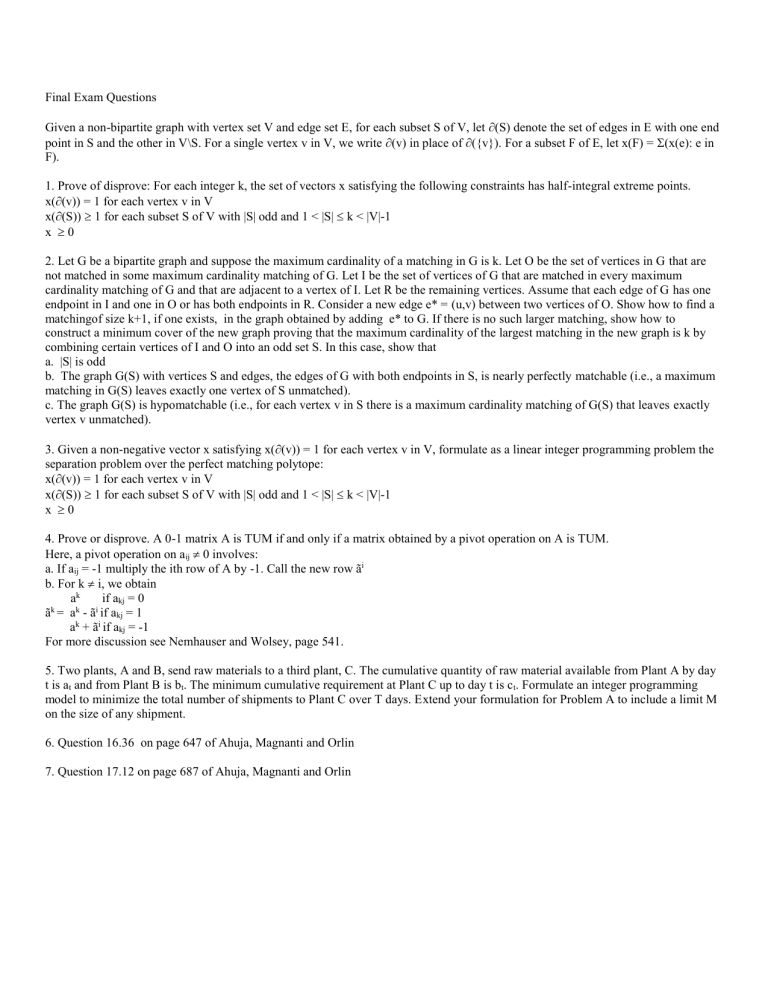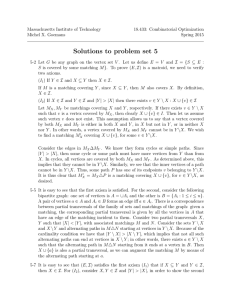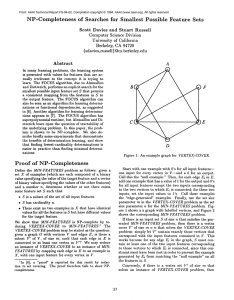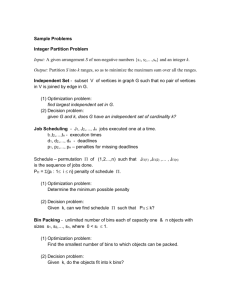Here - ISyE

Final Exam Questions
Given a non-bipartite graph with vertex set V and edge set E, for each subset S of V, let
(S) denote the set of edges in E with one end point in S and the other in V\S. For a single vertex v in V, we write
(v) in place of
({v}). For a subset F of E, let x(F) =
(x(e): e in
F).
1. Prove of disprove: For each integer k, the set of vectors x satisfying the following constraints has half-integral extreme points. x(
(v)) = 1 for each vertex v in V x(
(S))
1 for each subset S of V with |S| odd and 1 < |S|
k < |V|-1 x
0
2. Let G be a bipartite graph and suppose the maximum cardinality of a matching in G is k. Let O be the set of vertices in G that are not matched in some maximum cardinality matching of G. Let I be the set of vertices of G that are matched in every maximum cardinality matching of G and that are adjacent to a vertex of I. Let R be the remaining vertices. Assume that each edge of G has one endpoint in I and one in O or has both endpoints in R. Consider a new edge e* = (u,v) between two vertices of O. Show how to find a matchingof size k+1, if one exists, in the graph obtained by adding e* to G. If there is no such larger matching, show how to construct a minimum cover of the new graph proving that the maximum cardinality of the largest matching in the new graph is k by combining certain vertices of I and O into an odd set S. In this case, show that a. |S| is odd b. The graph G(S) with vertices S and edges, the edges of G with both endpoints in S, is nearly perfectly matchable (i.e., a maximum matching in G(S) leaves exactly one vertex of S unmatched). c. The graph G(S) is hypomatchable (i.e., for each vertex v in S there is a maximum cardinality matching of G(S) that leaves exactly vertex v unmatched).
3. Given a non-negative vector x satisfying x(
(v)) = 1 for each vertex v in V, formulate as a linear integer programming problem the separation problem over the perfect matching polytope: x(
(v)) = 1 for each vertex v in V x(
(S))
1 for each subset S of V with |S| odd and 1 < |S|
k < |V|-1 x
0
4. Prove or disprove. A 0-1 matrix A is TUM if and only if a matrix obtained by a pivot operation on A is TUM.
Here, a pivot operation on a ij
0 involves: a. If a ij
= -1 multiply the ith row of A by -1. Call the new row ã i b. For k
i, we obtain
a k if a kj
= 0
ã k = a k - ã i if a kj
= 1 a k + ã i if a kj
= -1
For more discussion see Nemhauser and Wolsey, page 541.
5. Two plants, A and B, send raw materials to a third plant, C. The cumulative quantity of raw material available from Plant A by day t is a t
and from Plant B is b t
. The minimum cumulative requirement at Plant C up to day t is c t
. Formulate an integer programming model to minimize the total number of shipments to Plant C over T days. Extend your formulation for Problem A to include a limit M on the size of any shipment.
6. Question 16.36 on page 647 of Ahuja, Magnanti and Orlin
7. Question 17.12 on page 687 of Ahuja, Magnanti and Orlin











